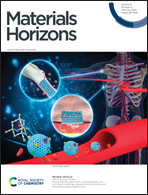Flexible boron nitride-based memristor for in situ digital and analogue neuromorphic computing applications†
Abstract
The data processing efficiency of traditional computers is suffering from the intrinsic limitation of physically separated processing and memory units. Logic-in-memory and brain-inspired neuromorphic computing are promising in-memory computing paradigms for improving the computing efficiency and avoiding high power consumption caused by extra data movement. However, memristors that can conduct digital memcomputing and neuromorphic computing simultaneously are limited by the difference in the information form between digital data and analogue data. In order to solve this problem, this paper proposes a flexible low-dimensional memristor based on boron nitride (BN), which has ultralow-power non-volatile memory characteristic, reliable digital memcomputing capabilities, and integrated ultrafast neuromorphic computing capabilities in a single in situ computing system. The logic-in-memory basis, including FALSE, material implication (IMP), and NAND, are implemented successfully. The power consumption of the proposed memristor per synaptic event (198 fJ) can be as low as biology (fJ level) and the response time (1 μs) of the neuromorphic computing is four orders of magnitude shorter than that of the human brain (10 ms), paving the way for wearable ultrahigh efficient next-generation in-memory computing architectures.



 Please wait while we load your content...
Please wait while we load your content...